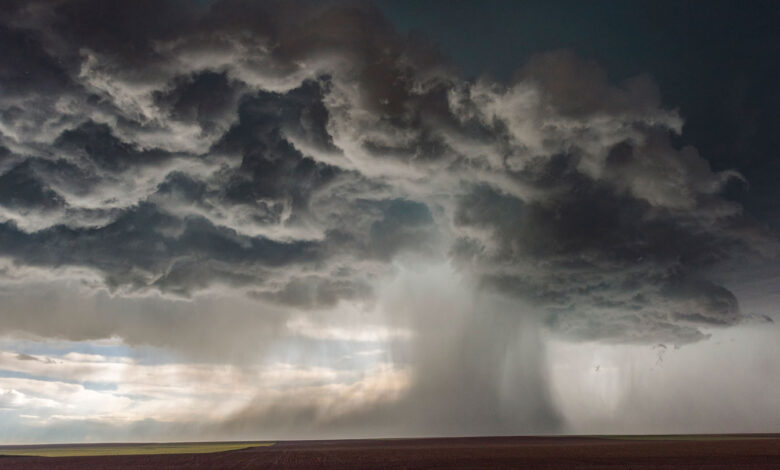How thunderstorms can spawn damaging ‘downbursts’

In July, a fierce thunderstorm raged through Washington, D.C., damaging homes, felling trees, producing blinding rain and leaving thousands without power. The storm was the District’s worst since a derecho swept through the Midwest and Mid-Atlantic regions in 2012 (SN: 8/27/20). Was the new damage the result of another derecho or a tornado? No, said area meteorologists. This time the culprit was a downburst.
These lesser-known products of severe storms first sparked U.S. public attention in the 1980s when one caused an airplane to crash near Dallas-Fort Worth International Airport, killing 137 people (SN: 3/21/87). Threats to aircraft have diminished thanks to more research on the phenomenon and greater monitoring of wind speeds at airports. But these fierce winds still pose a danger, evidenced by the damage left in the wake of severe storms that have battered the United States and parts of Europe this summer.
Here’s what to know about downbursts.
What are downbursts?
A downburst is an area of powerful winds produced by a storm with strong downward-moving air, known as a downdraft. When the downdraft reaches the ground, it slams into the surface and spreads out, sending winds outward in all directions like a water balloon dropped from the sky.
Every storm has a downdraft which sends cold air toward the ground and along the surface, says Charles Kuster, a research meteorologist at the National Severe Storms Laboratory in Norman, Okla. But for that downdraft to create a downburst, it needs to reach a certain velocity. There are a few different thresholds in use, but a common indicator is wind speeds above 93 kilometers per hour (58 miles per hour), which is also the wind speed that merits a severe thunderstorm warning from the National Weather Service.
Downbursts can come in two varieties: microbursts, which affect an area smaller than 4 kilometers wide, and macrobursts, which affect a larger area.
How do downbursts form?
Downbursts need two things to form: a favorable storm environment and a strong cooling mechanism. Humidity that increases with altitude and a large temperature difference between the storm and the surrounding environment both create favorable conditions for a downburst, as does high precipitation loading — the amount of rain or hail being held aloft by upward winds feeding into the storm.
The cooling mechanism can take a few different forms. Melting hail or evaporating rain in the atmosphere can cool the surrounding air because those processes require energy. Djordje Romanic, an atmospheric scientist at McGill University in Montreal, likens this cooling effect to stepping out of a hot shower. “You run across the room to get your towel, and you’re cold, but you just took a warm shower,” he says. “It’s possible because that water is evaporating, and evaporation takes energy” in the form of heat. The mass of dense, cooled air eventually becomes too heavy for the upward winds to keep it aloft and it falls to the earth, creating a downburst.
Downbursts don’t require rain, though. While “wet” downbursts are common across the southern United States, less humid western states more often experience “dry” downbursts. In certain cases, rain evaporates in the dry atmosphere before it hits the ground, cooling the air inside the storm.
How is a downburst different from a tornado?
Often when a downburst strikes, affected residents ascribe the damage to a tornado — and one could be forgiven for the mistake. Downbursts can generate winds that are about as powerful as a weak tornado, Romanic says. But the parallels end there. A tornado’s characteristic funnel cloud requires high wind shear — changes in wind speed or direction at different altitudes — to drive its rotation (SN: 12/14/18). By contrast, downbursts require low wind shear to keep from tearing the blob of lofted, cooler air apart.
Patterns of damage differ between the two as well, says Mark Rose, a meteorologist at the National Weather Service in Nashville. A tornado’s rotating winds will send debris in a swirling pattern, while the straight-line winds of a downburst tend to cause damage along a single direction.
Can downbursts be predicted?
Any area that has thunderstorms can encounter a downburst, though not every storm will produce these strong winds, Kuster says. Because downbursts “develop quickly and dissipate quickly,” he says, the damaging winds can strike with little to no warning.
Storms with the potential to produce downbursts can be detected by radar, which shows the location and the approximate speed of a storm’s most intense winds, Rose says. But because the radar grid is larger than a typical downburst, it’s difficult to predict exactly when and where a downburst will strike, Romanic says. Most reported downbursts are microbursts, he and colleagues reported in Weather and Climate Extremes in 2022.
The National Severe Storms Laboratory is studying a type of radar technology called phased array radar that could detect signs of an imminent downburst minutes before the downburst hits maximum intensity, potentially giving people in the affected area a few extra moments to prepare.
Will downbursts get worse with climate change?
It’s hard to say. Reports of downbursts have increased over the years, but Romanic cautions that much of that increase could be tied to improvements in detection via radar, and to the greater potential for damage as cities have grown. After accounting for those factors, there hasn’t been a significant increase in downbursts since the 1990s, he says.
But that doesn’t mean extra heat has no effect on downbursts. Anything that increases a storm’s energy increases the likelihood of severe winds, Kuster says. That includes higher temperatures and more humidity. As summers get hotter, the planet could see more storms with the potential to produce downbursts, researchers suspect.
For now, Kuster emphasizes that while downbursts may not be as common as a typical thunderstorm or as well-known as a tornado, they are still hazardous. “Downbursts are serious. Severe thunderstorm warnings are serious,” he says. “So when you go under a severe thunderstorm warning, make sure that you take shelter.”
Source



